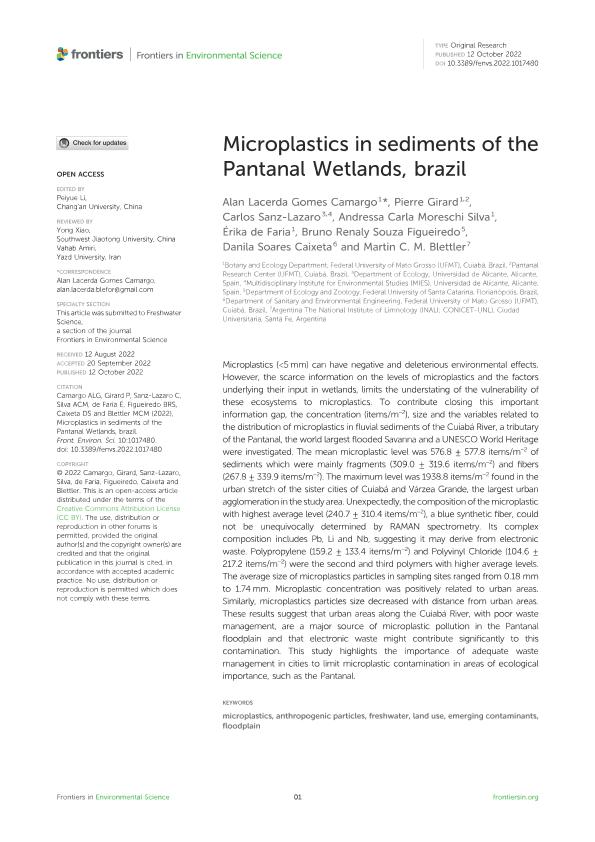Mostrar el registro sencillo del ítem
dc.contributor.author
Camargo, Alan Lacerda Gomes
dc.contributor.author
Girard, Pierre
dc.contributor.author
Sanz Lazaro, Carlos
dc.contributor.author
Moreschi Silva, Andressa Carla
dc.contributor.author
de Faria, Érika
dc.contributor.author
Souza Figueiredo, Bruno Renaly
dc.contributor.author
Caixeta, Danila Soares
dc.contributor.author
Blettler, Martin Cesar Maria

dc.date.available
2023-09-28T18:07:15Z
dc.date.issued
2022-10
dc.identifier.citation
Camargo, Alan Lacerda Gomes; Girard, Pierre; Sanz Lazaro, Carlos; Moreschi Silva, Andressa Carla; de Faria, Érika; et al.; Microplastics in sediments of the Pantanal Wetlands, Brazil; Frontiers Media; Frontiers in Environmental Science; 10; 10-2022; 1-12
dc.identifier.uri
http://hdl.handle.net/11336/213485
dc.description.abstract
Microplastics (<5 mm) can have negative and deleterious environmental effects. However, the scarce information on the levels of microplastics and the factors underlying their input in wetlands, limits the understating of the vulnerability of these ecosystems to microplastics. To contribute closing this important information gap, the concentration (items/m−2), size and the variables related to the distribution of microplastics in fluvial sediments of the Cuiabá River, a tributary of the Pantanal, the world largest flooded Savanna and a UNESCO World Heritage were investigated. The mean microplastic level was 576.8 ± 577.8 items/m−2 of sediments which were mainly fragments (309.0 ± 319.6 items/m−2) and fibers (267.8 ± 339.9 items/m−2). The maximum level was 1938.8 items/m−2 found in the urban stretch of the sister cities of Cuiabá and Várzea Grande, the largest urban agglomeration in the study area. Unexpectedly, the composition of the microplastic with highest average level (240.7 ± 310.4 items/m−2), a blue synthetic fiber, could not be unequivocally determined by RAMAN spectrometry. Its complex composition includes Pb, Li and Nb, suggesting it may derive from electronic waste. Polypropylene (159.2 ± 133.4 items/m−2) and Polyvinyl Chloride (104.6 ± 217.2 items/m−2) were the second and third polymers with higher average levels. The average size of microplastics particles in sampling sites ranged from 0.18 mm to 1.74 mm. Microplastic concentration was positively related to urban areas. Similarly, microplastics particles size decreased with distance from urban areas. These results suggest that urban areas along the Cuiabá River, with poor waste management, are a major source of microplastic pollution in the Pantanal floodplain and that electronic waste might contribute significantly to this contamination. This study highlights the importance of adequate waste management in cities to limit microplastic contamination in areas of ecological importance, such as the Pantanal.
dc.format
application/pdf
dc.language.iso
eng
dc.publisher
Frontiers Media

dc.rights
info:eu-repo/semantics/openAccess
dc.rights.uri
https://creativecommons.org/licenses/by/2.5/ar/
dc.subject
ANTHROPOGENIC PARTICLES
dc.subject
EMERGING CONTAMINANTS
dc.subject
FLOODPLAIN
dc.subject
FRESHWATER
dc.subject
LAND USE
dc.subject
MICROPLASTICS
dc.subject.classification
Ciencias Medioambientales

dc.subject.classification
Ciencias de la Tierra y relacionadas con el Medio Ambiente

dc.subject.classification
CIENCIAS NATURALES Y EXACTAS

dc.title
Microplastics in sediments of the Pantanal Wetlands, Brazil
dc.type
info:eu-repo/semantics/article
dc.type
info:ar-repo/semantics/artículo
dc.type
info:eu-repo/semantics/publishedVersion
dc.date.updated
2023-07-18T14:26:56Z
dc.identifier.eissn
2296-665X
dc.journal.volume
10
dc.journal.pagination
1-12
dc.journal.pais
Suiza

dc.journal.ciudad
Lausana
dc.description.fil
Fil: Camargo, Alan Lacerda Gomes. Universidade Federal Do Mato Grosso (ufmt);
dc.description.fil
Fil: Girard, Pierre. Universidade Federal Do Mato Grosso (ufmt); . Pantanal Research Center; Brasil
dc.description.fil
Fil: Sanz Lazaro, Carlos. Universidad de Alicante; España
dc.description.fil
Fil: Moreschi Silva, Andressa Carla. Universidade Federal Do Mato Grosso (ufmt);
dc.description.fil
Fil: de Faria, Érika. Universidade Federal Do Mato Grosso (ufmt);
dc.description.fil
Fil: Souza Figueiredo, Bruno Renaly. Universidade Federal de Santa Catarina; Brasil
dc.description.fil
Fil: Caixeta, Danila Soares. Universidade Federal Do Mato Grosso (ufmt);
dc.description.fil
Fil: Blettler, Martin Cesar Maria. Consejo Nacional de Investigaciones Científicas y Técnicas. Centro Científico Tecnológico Conicet - Santa Fe. Instituto Nacional de Limnología. Universidad Nacional del Litoral. Instituto Nacional de Limnología; Argentina
dc.journal.title
Frontiers in Environmental Science
dc.relation.alternativeid
info:eu-repo/semantics/altIdentifier/url/https://www.frontiersin.org/articles/10.3389/fenvs.2022.1017480/full
dc.relation.alternativeid
info:eu-repo/semantics/altIdentifier/doi/http://dx.doi.org/10.3389/fenvs.2022.1017480
Archivos asociados
